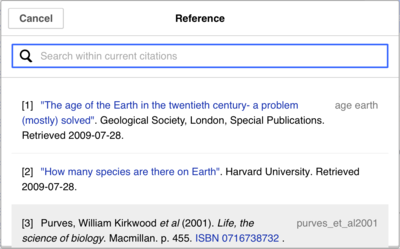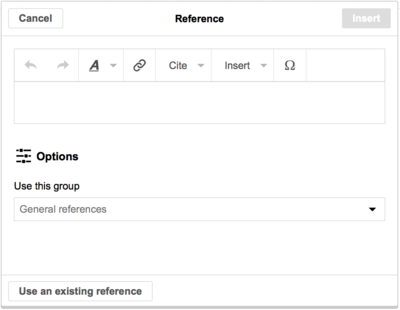|
Determining which system is in place
|
| Your wiki may use one of three footnote systems.
The one shown on the right is the simplest system, where the "Atsauce" menu does not include any citation templates.
If your wiki uses this system, then everything you need to know about footnotes is on this page.
|

|
|
|
|

|
| In the second system, you again start by pressing the Atsauce button.
Then a dialog box opens, which includes several popular citation templates set up for quick access in the "Manu?li" tab.
If your wiki uses this system, then you will find more details at
Help:VisualEditor/User guide/Citations-Templates
|

|
|
| In the third system, you again start by pressing the Atsauce button.
Then a dialog box opens, which includes an automatic citation process using the citoid service under the Automatic tab.
If your wiki uses this system, you will find more details at
Help:VisualEditor/User guide/Citations-Full
|

|
|
Redi??t eksist?jo?u atsauci
|
| To edit an existing reference, press on it where it appears in the text (usually as a bracketed number). You will see either a "Atsauce" icon (bookmark) or an icon (and name) for the template that was used to create this reference. In either case, pressing on the "Labot" button will open a dialog where you can edit the reference.
|

|
|
For the "Atsauce" icon, pressing "Labot" opens the reference dialog. To start changing the reference information, press on it.
Vikip?dija latvie?u valod? p?rsvar? lieto veides, lai format?tu atsauces p?c specifiska standarta. Tu paman?si to, ja, redi??jot eksist?jo?u atsauci, viss saturs iekr?sosies zils, kad tu izv?lies to.
If a template was used and you press on the reference information, then the Veidne icon (puzzle piece) will appear with some information. Press on the "Labot" button to edit the content of the template in the template editor dialog.
|

|
|
| If what appears when you press on a reference is an icon for a standard template for citations (an example is at right), then pressing "Labot" will open the template editor dialog.
|

|
|
| Inside the template editor, you can add or remove types of information or change current content. Only fields (template parameters) that have content will show, initially. To add fields, press on "Pievienot" at the bottom of the editor.
|

|
|
| Kad pabeigts, uzspied uz pogas "Lietot izmai?as".
|

|
|
Izmantojot jau eso?u atsauci
|
If the page already contains a citation that applies to the text you want to source, then you can choose to re-use that existing citation.
Lai atkal izmantotu jau eksist?jo?u atsauci, novieto kursoru viet?, kur tu v?lies to pievienot un nospied ikonu "Atsauce" (gr?matz?me) r?kjosl?.
(Note: If your wiki has the second or third footnote system described above, you'll see a "Atk?rtota izmanto?ana" tab, in a dialog, instead of a "Atk?rtota izmanto?ana" item on the "Atsauce" menu.)
|

|
|
| Ja lap? ir vair?kas atsauces, tu vari lietot mekl??anas lauku (ar nosaukumu "Uz ko j?s v?laties atsaukties?"), lai r?d?tu tikai t?s atsauces, kas atbilst dotajam tekstam. Mekl? sarakst? atsauci, ko tu v?lies atk?rtoti izmantot un izv?lies to.
|

|
|
Jaunas atsauces pievieno?ana
|
| Lai pievienotu jaunu atsauci, novieto kursoru viet?, kur tu v?lies to pievienot un nospied ikonu "Atsauce" (gr?matz?me) r?kjosl?.
Then click "Vienk?r?a".
|

|
Izmantojot "Parasto" cit??anu
|
| Shown here is what you will see if you select the basic references item.
Atsau?u redaktor? tu vari pievienot un noform?t atsauci.
Tu vari atsauces piesaist?t dotai grupai; tas tiek lietots lai par?d?tu atsau?u grupas ar "Atsau?u sarakstu" (veidne "Atsauces").
|

|
|
| Ja tu pievieno jaunu atsauci un v?lies taj? iek?aut veidne, uzspied uz ikonas "Iek??vums" (puzles gabali??) atsauces redaktora r?kjosl?.
|

|
|
P?ctam samekl? veidni, ko tu v?lies lietot, pievieno to un redi?? k? tu to dar?tu ar jau eksist?jo?u.
Uzspied uz pogas "Lietot izmai?as", lai atgrieztos pie atsau?u redaktora un "Lietot izmai?as" atkal, lai atgrieztos lap?.
|

|
|
Ja lap? jau nav atsau?u saraksta (piem?ram, ja tu pievieno pirmo lapas atsauci), tev vajag to pievienot, lai atsauces teksts tiktu r?d?ts.
Novieto kursoru tur, kur tu v?lies par?d?t atsauces (parasti lapas beig?s), uz uzspied uz ikonas "Atsau?u saraksts" (tr?s gr?matas), la pievienotu to.
|

|
|
| Ja J?s izmantojat da??das atsau?u grupas, J?s varat izv?l?ties grupu ?aj? dialog?. Atsuaces, kas pieder ?ai grupai, tiks att?lotas.
Lai vienk?r?i pievienotu atsau?u sarakstu, nospied "Ievietot" dialog?.
|

|
Izmantojot standarta cit??anas veidnes
|
| Your local wiki may have added extra citation templates to the "Atsauce" menu. If so, you have quick access to the most-used citation templates for your wiki.
(Instructions for adding extra citation templates to your local wiki are available at
VisualEditor/Citation tool
.)
|

|
|
| Pressing on a template icon such as "Cite book" will take you into the template editor for that template. Important information fields may be marked with an asterisk. While the most common fields will be shown, not all of them are required.
|

|
|
| To add more parameters, scroll down in the template editor and press on the "Pievienot" option.
Nospied "Ievietot", kad ir pabeigts.
|

|